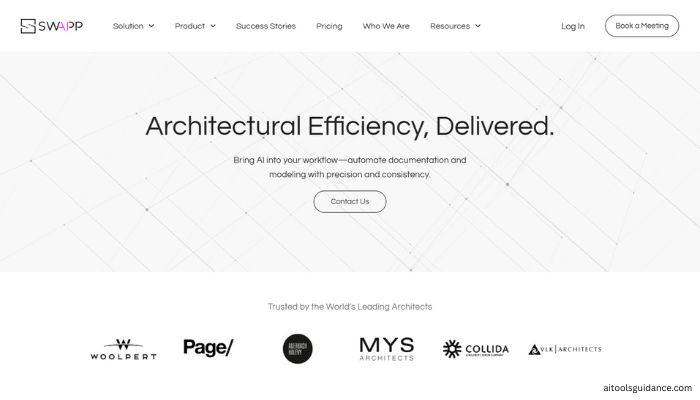Introduction
Architects today face growing demands to deliver projects faster, with greater precision, and without sacrificing creativity. As project timelines shrink and client expectations rise, many are turning to artificial intelligence to streamline their workflows. Among the standout tools in this space is SWAPP, an AI-powered platform designed to revolutionize architectural documentation and modeling. By automating repetitive tasks, SWAPP AI empowers architects to focus on what they do best: designing innovative, impactful spaces.
In this blog, we’ll explore how SWAPP transforms architectural practices by diving into its core features, benefits, and real-world applications. You’ll discover how this tool saves time, boosts accuracy, and enhances profitability for firms of all sizes. Whether you’re an architect, BIM specialist, or curious about AI in architecture, this article will show you why SWAPP AI is reshaping the industry and how you can integrate it into your workflow.

What is SWAPP?
SWAPP is an AI-driven platform that automates the most time-consuming aspects of architectural planning, particularly construction documentation and modeling. Built by a team of architects, data scientists, and AI experts, SWAPP AI combines advanced machine learning with human expertise to deliver high-quality, firm-specific outputs. As highlighted on the SWAPP website, the platform focuses on eliminating tedious tasks, allowing architects to prioritize creative design over manual drafting.
At its core, SWAPP analyzes a firm’s previous projects to understand its unique design habits and standards. It then uses this data to generate precise documentation and Building Information Modeling (BIM) models tailored to the firm’s practices. For example, SWAPP AI can produce detailed floor plans, elevations, and MEP (mechanical, electrical, plumbing) layouts in minutes, a process that traditionally takes hours or days. This automation not only accelerates project timelines but also ensures consistency across deliverables, making SWAPP a game-changer for architectural firms.
The platform’s ability to integrate seamlessly with existing workflows sets it apart. Instead of requiring architects to learn new software, SWAPP AI works alongside tools like Revit, enhancing rather than disrupting established processes. With a focus on precision, efficiency, and customization, SWAPP empowers architects to tackle complex projects with confidence.
Key Features of SWAPP
SWAPP AI offers a robust suite of features that address the pain points of architectural documentation and modeling. Below, we break down its core capabilities, which have helped deliver over 22.7 million square feet of successful architectural projects.
1. Automated Documentation
One of SWAPP’s standout features is its ability to generate full drawing sets with remarkable speed and precision. This includes floor plans, elevations, sections, and MEP layouts, all annotated with firm-specific details like door styles, wall types, and fixtures. By automating these tasks, SWAPP AI reduces the time spent on repetitive drafting, allowing architects to focus on design innovation. For instance, what once took hours of manual work can now be completed in minutes, with annotations that adhere to industry standards and firm preferences.
2. Custom Rule Sets
SWAPP doesn’t rely on generic templates. Instead, it analyzes a firm’s past projects—typically four to five BIM models—to create tailored algorithms that reflect the firm’s unique design habits. These custom rule sets ensure that every output, from floor plans to casework details, aligns with the firm’s standards. For example, SWAPP AI can replicate specific wall finishes or furniture layouts used in previous projects, ensuring consistency across new designs. This personalized approach makes SWAPP a powerful tool for maintaining brand identity and quality.
3. BIM Integration
Seamless integration with existing BIM software, such as Revit, is a cornerstone of SWAPP’s functionality. Architects can upload their BIM models, and SWAPP AI enhances them by automating tasks like dimensioning, tagging, and parameter extraction. This vendor-agnostic, cloud-based system ensures that SWAPP fits into existing workflows without requiring significant changes. As a result, firms can adopt SWAPP AI quickly, boosting productivity without disrupting their processes.
4. Cloud-Based Collaboration
SWAPP’s cloud-based platform enables teams to collaborate efficiently, whether they’re in the office or working remotely. Project data is accessible in real time, allowing architects, BIM specialists, and project managers to review and revise documents seamlessly. SWAPP AI also supports project iterations by automatically updating drawings and models when changes are made, reducing the risk of errors and miscommunication. This feature is particularly valuable for large-scale projects with multiple stakeholders.
| Feature | Description | Benefit |
|---|---|---|
| Automated Documentation | Generates floor plans, elevations, MEP layouts, and annotations in minutes. | Saves hours of manual drafting, freeing time for creative design. |
| Custom Rule Sets | Analyzes past projects to create firm-specific algorithms for consistent outputs. | Ensures deliverables align with firm standards and design habits. |
| BIM Integration | Works seamlessly with tools like Revit, enhancing existing workflows. | Reduces learning curve and integrates with current software. |
| Cloud-Based Collaboration | Enables real-time access and updates for teams, in-office or remote. | Improves teamwork and reduces errors during project iterations. |
Highlight: SWAPP has successfully delivered over 22.7 million square feet of architectural projects, demonstrating its reliability and impact across diverse verticals, from multifamily housing to educational facilities.
Benefits of Using SWAPP in Architectural Projects
SWAPP AI delivers tangible benefits that transform how architectural firms operate. By automating repetitive tasks and enhancing workflows, it addresses key challenges like time constraints, error-prone documentation, and profitability pressures. Here’s how SWAPP makes a difference.
1. Time Savings
Manual drafting is one of the most time-intensive tasks in architecture. SWAPP tackles this by automating up to 80% of construction documentation tasks, potentially cutting project timelines by 50%. For example, tasks like dimensioning floor plans or annotating casework, which could take hours, are completed in minutes with SWAPP AI. This allows architects to allocate more time to client meetings, design ideation, and strategic planning, ultimately accelerating project delivery.
2. Improved Accuracy
Errors in documentation can lead to costly revisions and delays. SWAPP minimizes these risks by validating models against firm standards and industry best practices. Its AI-driven precision ensures that every element—doors, walls, fixtures—is accurately tagged and dimensioned. For instance, SWAPP AI verifies the legibility and aesthetics of each view, adjusting annotations to meet firm-specific requirements. This results in professional-grade documentation that exceeds industry standards.
3. Enhanced Profitability
By streamlining workflows, SWAPP enables firms to handle multiple projects simultaneously without increasing overtime hours. This efficiency translates to higher revenue and improved profit margins. Additionally, SWAPP AI frees up junior architects from repetitive tasks, allowing them to take on more valuable roles, which enhances talent retention and firm growth. As Justin S. Hiles, Chief Information Officer at VLK Architects, noted, “After being with SWAPP for a year, we had no doubts about renewing again, this time even tripling the square footage goals because it just makes sense.”
4. Real-World Impact
The impact of SWAPP is evident in case studies from leading firms. For example, VLK Architects reported tripling their square footage goals after adopting SWAPP AI, thanks to its ability to reduce manual workloads by eightfold. Similarly, MYS Architects’ CEO, Oleg Malukov, stated that SWAPP “significantly boosted our capabilities” by automating tedious tasks. These success stories highlight how SWAPP empowers firms to achieve ambitious goals while maintaining high-quality outputs.
| Benefit | Impact | Example |
|---|---|---|
| Time Savings | Cuts documentation time by up to 50%. | Completes floor plan annotations in minutes instead of hours. |
| Improved Accuracy | Reduces errors through AI validation and firm-specific standards. | Ensures consistent tagging for doors, walls, and fixtures. |
| Enhanced Profitability | Enables handling multiple projects, boosting revenue and retention. | VLK Architects tripled square footage goals with SWAPP. |
| Real-World Impact | Proven results in large-scale projects across multifamily and educational sectors. | MYS Architects reduced manual workload by eightfold. |
How SWAPP Stands Out in the AI Tools Market
The architectural AI market is growing, with tools like Sabana and VIKTOR.AI offering automation for engineering and design tasks. However, SWAPP distinguishes itself through its focus on personalized automation and robust integration. Let’s compare SWAPP AI to its competitors and explore its unique strengths.
Comparison with Other AI Tools
Unlike Sabana, which focuses on MEP engineering automation, SWAPP targets the entire architectural documentation process, from schematic design to construction documents. VIKTOR.AI, on the other hand, emphasizes custom web apps for engineers, whereas SWAPP AI specializes in BIM-based workflows for architects. While tools like Snaptrude offer collaborative design features, SWAPP excels in generating firm-specific documentation, such as detailed floor plans and elevations, tailored to past project data.
Unique Selling Point: Personalized Automation
SWAPP’s standout feature is its ability to learn from a firm’s previous projects. By analyzing four to five BIM models, SWAPP AI creates custom rule sets that reflect the firm’s design habits, such as specific wall constructions or furniture layouts. This ensures that outputs are not only accurate but also aligned with the firm’s aesthetic and functional preferences. No other tool in the market offers this level of personalization, making SWAPP ideal for firms with established standards.
Data Security and Certification
Data security is a top priority for architectural firms, and SWAPP addresses this with its ISO/IEC 27001:2022 certification. The platform uses state-of-the-art encryption and trains models exclusively on client data, ensuring that proprietary information remains private. Unlike some competitors, SWAPP AI guarantees that firms retain ownership of their outputs, providing peace of mind for sensitive projects.
| Tool | Focus | Strengths | Limitations |
|---|---|---|---|
| SWAPP | Architectural documentation and BIM | Personalized automation, BIM integration | Tailored pricing may require consultation |
| Sabana | MEP engineering automation | Specialized for MEP systems | Limited to engineering tasks |
| VIKTOR.AI | Custom web apps for engineers | Flexible app creation | Less focus on architectural documentation |
| Snaptrude | Collaborative design and visualization | Real-time model sharing | Less emphasis on firm-specific automation |
Who Should Use SWAPP?
SWAPP AI is designed for a wide range of users in the architectural and construction industries. Its versatility makes it suitable for both traditional and innovative applications. Here’s who can benefit most from SWAPP.
Target Audience
- Architectural Firms: Large firms like Woolpert and VLK Architects use SWAPP to streamline documentation for multifamily, educational, and commercial projects.
- BIM Specialists: Professionals managing BIM workflows can leverage SWAPP AI to automate parameter extraction and model validation.
- Design Teams: Collaborative teams benefit from SWAPP’s cloud-based platform, which supports real-time updates and revisions.
- Project Managers: Managers overseeing large-scale developments can use SWAPP to reduce costs and accelerate timelines.
Uncommon Use Cases
Beyond traditional applications, SWAPP AI is gaining traction in unique scenarios. Educational institutions can use SWAPP to teach students about AI-driven design, incorporating real-world tools into curricula. Real estate developers can also leverage SWAPP to visualize potential projects, generating detailed plans for feasibility studies. These use cases highlight SWAPP’s flexibility in addressing diverse needs.
Ideal for All Firm Sizes
Whether you’re a small practice or a global firm, SWAPP AI scales to meet your needs. Smaller firms benefit from reduced manual workloads, allowing them to compete with larger players. Large firms, meanwhile, can handle more projects simultaneously, as demonstrated by MYS Architects’ eightfold workload reduction. SWAPP’s tailored pricing ensures affordability for firms of any size.
Getting Started with SWAPP
Integrating SWAPP AI into your workflow is straightforward and designed to minimize disruption. Here’s how to get started and maximize its potential.
Steps to Integrate SWAPP
- Contact the SWAPP Team: Reach out via the SWAPP website to discuss your firm’s needs and project scope.
- Provide Reference Models: Submit four to five BIM models for SWAPP AI to analyze and create custom rule sets.
- Customize Rule Sets: Work with SWAPP’s professional team to tailor algorithms to your firm’s standards.
- Start Automating: Upload new projects to SWAPP, and let it generate documentation and models in minutes.
- Review and Revise: Use the cloud-based platform to collaborate with your team and make real-time updates.
Pricing
SWAPP offers flexible pricing based on project size and vertical (e.g., commercial, residential). Costs are calculated per square foot, ensuring alignment with your project’s complexity. To get a personalized quote, contact the SWAPP AI team directly. This tailored approach ensures that firms of all sizes can access SWAPP’s benefits without overpaying.
Tips for Maximizing SWAPP’s Potential
- Leverage BIM Integration: Use SWAPP with Revit or AutoCAD to enhance existing workflows.
- Utilize Cloud Collaboration: Encourage team members to access project data in real time for seamless communication.
- Train on Diverse Projects: Provide a variety of past models to ensure SWAPP AI captures your firm’s full range of design habits.
- Monitor Updates: Take advantage of SWAPP’s automatic revision features to keep documentation current.
Frequently Asked Questions
1. What does SWAPP mean?
SWAPP stands for an AI-powered platform that streamlines architectural processes. The name reflects its mission to “swap” manual, time-consuming tasks with automated, efficient solutions, enabling architects to focus on creative design.
2. What does SWAPP do?
SWAPP automates architectural documentation and modeling, generating precise drawing sets like floor plans, elevations, and MEP layouts. Using SWAPP AI, it analyzes past projects to create firm-specific outputs, saving time and boosting accuracy.
3. Is SWAPP AI free?
SWAPP AI is not free; it offers tailored pricing based on project size and firm needs. Contact the SWAPP team for a personalized quote. The platform’s value lies in its ability to save hours and enhance profitability.
4. How does SWAPP integrate with BIM tools?
SWAPP AI seamlessly integrates with Building Information Modeling (BIM) software like Revit. It enhances existing workflows by automating tasks such as dimensioning and tagging, ensuring compatibility without disrupting your process.
5. Who can benefit from using SWAPP?
Architectural firms, BIM specialists, design teams, and project managers benefit from SWAPP. It’s ideal for large firms handling multifamily projects or small practices aiming to compete with bigger players.
6. How does SWAPP ensure accuracy in documentation?
SWAPP AI validates models against firm standards and industry best practices, minimizing errors in annotations and dimensions. This ensures professional-grade outputs for every project.
7. Can SWAPP be used for small architectural firms?
Yes, SWAPP scales to suit small firms by reducing manual workloads, allowing them to take on more projects efficiently. Its custom rule sets adapt to any firm’s design habits.
8. How does SWAPP save time for architects?
By automating up to 80% of documentation tasks, SWAPP AI cuts drafting time by up to 50%. For example, it generates annotated floor plans in minutes, freeing architects for creative tasks.
9. What makes SWAPP different from other AI tools?
Unlike tools like Sabana or VIKTOR.AI, SWAPP focuses on personalized automation, learning firm-specific standards from past BIM models to deliver tailored, high-quality outputs.
10. How secure is SWAPP for sensitive project data?
SWAPP AI prioritizes data security with ISO/IEC certification. It uses client-specific data training and encryption, ensuring your proprietary information remains protected.
Conclusion
SWAPP is transforming the architectural industry by automating tedious documentation and modeling tasks, allowing architects to focus on creativity and innovation. With features like automated documentation, custom rule sets, BIM integration, and cloud-based collaboration, SWAPP AI delivers unmatched efficiency, accuracy, and profitability. Its proven impact—over 22.7 million square feet of projects delivered and success stories from firms like VLK and MYS Architects—makes it a must-have tool for modern practices.
Ready to see how SWAPP can elevate your projects? Visit the SWAPP website to explore its features or contact their team for a personalized demo. For more insights on AI tools like SWAPP AI, Explore Ai Tools Guidance and stay updated on the latest trends. Have you used SWAPP or other AI tools in your projects? Share your experiences in the comments below—we’d love to hear your thoughts!










